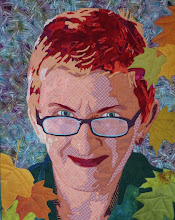Jill P. Hoddick of Portland, Oregon
1. How would you describe the work that you make? Do you have an elevator speech? Have you found your "artistic voice"?

1. How would you describe the work that you make? Do you have an elevator speech? Have you found your "artistic voice"?
The fusion of color, line, and texture become one in my studio. The fabrics are filled with dynamic motifs and flooded in bright colors. Line is often curved and shapes are cut and pieced improvisationally. The texture becomes uneven with the addition of extensive free motion stitching. My inspiration comes from varied places- an emotion, a word, a photograph. I want to capture a moment in time for the viewer.
As an artist I hope that my artistic voice keeps evolving as I mature, the world around me changes, and I learn from myself and other artists.
2. What brought you to making fiber art? What is your art, sewing, or fiber background? When did you make your first quilt that you considered "art"?
I took a semester of home ec sewing in 7th grade and had a great teacher who challenged me with interesting projects. I went from gym bag to apron to shorts to a dress (it even fit!) in a semester. I expanded that knowledge to sewing quite a few outfits for myself and designing and constructing costumes for school productions. I also was lucky enough to spend summers at a wonderful place called Idyllwild School of Music and the Arts in Southern California. In my middle school years I attended a program there called the Jr. Players. This group produced 3 plays a summer often including a Shakespeare and a musical. Students learned technical skills such as lighting, set construction, and costumes as well as acting. I wandered into the costume shop one day and never looked back. Finally the director noticed I was missing from the rehearsal of A Midsummer Night’s Dream and suggested I quickly build a fairy costume and she would work me in so my family would see me on stage. I spent 3 years in Jr. Players, returned to assist the Costume Designer and then took on that position for 3 years when I was in college. This experience began my 40 year career as a Costume Designer and established my love of all things fiber. I retired from 35 years as Professor of Theatrical Costume Design at University of Portland in 2012.
Although I made a couple of self designed bed quilts, I have no training in quilting. I consider my first art quilt to be Oregon Culture Connection (2010) that was exhibited in SAQA Oregon’s first regional exhibition “Oregon: State of Diversity.”
3. Describe the steps involved in your art-making process.
I primarily work in an improvisational manner. Occasionally I draw a sketch or use more specific approaches, depending upon the subject matter. If I am experimenting with a new technique (raw edge strata) I sometimes do a smaller sample quilt as I did with South Rim, Grand Canyon shown at the end of this dialogue.
4. What is your one favorite or most common source of inspiration?
Photographs – of the coast, forests, flowers, sunsets, architecture
5. Do you enter your work in shows? What would you say have been your top three exhibits?
“What’s Blue to You?,” Indigo Forest. I loved having our HFD work shown at the PDX Airport (2014)– it was great fun to receive calls and emails from friends who saw that show while they were traveling.
Indigo Forest at the Portland International Airport
What's Blue to You?, exhibit by High Fiber Diet 2015
Red Syncopation
Exhibited in Simply Red, HFD
This quilt SOLD!
“ Rhythm and Hues II” - When I viewed this HFD exhibit at Mt. Hood Community College (2013) I had several wonderful interactions with students who were unfamiliar with art and or art quilts.
6. Describe your studio space.
I have adequate space and storage in an upstairs bedroom. It houses my hat and purse collection as well as tons of other art/quilting supplies. It is a mess most of the time, but I seem to thrive in that environment.
7. How much time do you spend on your art? How do you balance your life between art, family, friends, day job, etc.?
I try to spend 4-6 hours, five days a week in my studio or working at my craft. Besides my daily morning workouts at Curves or Aqua Power Class most of my time is devoted to creating art. I belong to CFG, HFD, SDA, and a small challenge group and all of these groups feed my soul and offer social as well as educational and intellectual opportunities. I am lucky to have a very supportive husband and daughter who attend exhibitions and receptions and assist me when necessary.
8. Do you work in other mediums or use unusual materials in your work?
I enjoy using fabrics other than cotton in my work. These come mostly from my costume scrap stash (I have many garbage bags full to utilize!).

South Rim, Grand Canyon
Exhibited in Exploring Layers, SAQA Oregon 2014
All photos by Hoddick Photography

















